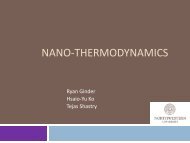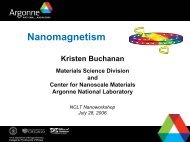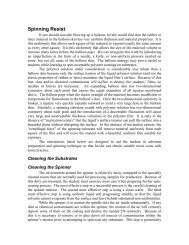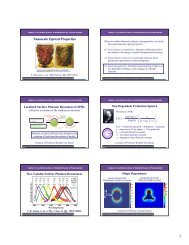A Practical Guide to SPM
A Practical Guide to SPM
A Practical Guide to SPM
You also want an ePaper? Increase the reach of your titles
YUMPU automatically turns print PDFs into web optimized ePapers that Google loves.
5<br />
a sample surface, the sensed interaction can be correlated <strong>to</strong> the<br />
distance between the probe and sample. Since the magnitude of this<br />
interaction varies as a function of the probe-sample distance, the <strong>SPM</strong><br />
can map a sample’s surface <strong>to</strong>pography by scanning the probe in a<br />
precise, controlled manner over the sample surface.<br />
The Scanner<br />
The material that provides the precise positioning control required by<br />
all <strong>SPM</strong> scanners is piezoelectric ceramic. Piezoelectric ceramic<br />
changes its geometry when a voltage is applied; the voltage applied<br />
is proportional <strong>to</strong> the resulting mechanical movement.<br />
The piezoelectric scanner in an <strong>SPM</strong> is designed <strong>to</strong> bend, expand,<br />
and contract in a controlled, predictable manner. The scanner,<br />
therefore, provides a way of controlling the probe-sample distance<br />
and of moving the probe over the surface.<br />
Means of sensing the<br />
vertical position of the tip<br />
A feedback system <strong>to</strong><br />
control the vertical<br />
position of the tip<br />
A probe tip<br />
A coarse positioning<br />
system <strong>to</strong> bring the<br />
tip in<strong>to</strong> the general<br />
vicinity of the sample<br />
Scanning: Setpoint, Detec<strong>to</strong>r Signal, and Error Signal<br />
In order <strong>to</strong> generate an <strong>SPM</strong> image, the scanner moves the probe tip<br />
close enough <strong>to</strong> the sample surface for the probe <strong>to</strong> sense the probesample<br />
interaction. Once within this regime, the probe produces a<br />
signal representing the magnitude of this interaction, which<br />
corresponds <strong>to</strong> the probe-sample distance. This signal is referred <strong>to</strong> as<br />
the detec<strong>to</strong>r signal (Figure 2-1).<br />
Figure 2-1. <strong>SPM</strong> feedback loop.<br />
A piezoelectric scanner that moves<br />
the sample under the tip (or the tip<br />
over the sample) in a raster pattern<br />
A computer system that<br />
drives the scanner,<br />
measures data, and<br />
converts the data in<strong>to</strong><br />
an image<br />
In order for the detec<strong>to</strong>r signal <strong>to</strong> be meaningful, a reference value<br />
known as the setpoint is established. When the scanner moves the<br />
probe in<strong>to</strong> the imaging regime, the detec<strong>to</strong>r signal is moni<strong>to</strong>red and<br />
compared <strong>to</strong> the setpoint. When the detec<strong>to</strong>r signal is equal <strong>to</strong> the<br />
setpoint, the scanning can begin.<br />
The scanner moves the probe over the surface in a precise, defined<br />
pattern known as a raster pattern, a series of rows in a zigzag pattern<br />
covering a square or rectangular area. As the probe encounters<br />
changes in the sample <strong>to</strong>pography, the probe-sample distance<br />
changes, triggering a corresponding variance in the detec<strong>to</strong>r signal.<br />
The data for generating an <strong>SPM</strong> image is calculated by comparing<br />
the detec<strong>to</strong>r signal <strong>to</strong> the setpoint. The difference between these two<br />
values is referred <strong>to</strong> as the error signal, which is the raw data used<br />
<strong>to</strong> generate an image of the surface <strong>to</strong>pography.<br />
Data can be collected as the probe moves from left <strong>to</strong> right (the<br />
“trace”) and from right <strong>to</strong> left (the “retrace”). The ability <strong>to</strong> collect data<br />
in both directions can be very useful in fac<strong>to</strong>ring out certain effects that<br />
do not accurately represent the sample surface. The trace-and-retrace<br />
movement is sometimes referred <strong>to</strong> as the “fast scan direction.” The<br />
direction perpendicular <strong>to</strong> the fast scan direction is sometimes referred<br />
<strong>to</strong> as the “slow scan direction.”
















